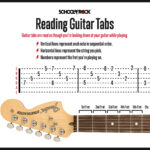The C minor chord (Cm) is a foundational chord for guitarists across genres, adding depth and emotion to countless songs. While it might seem challenging at first, especially for beginners, understanding its construction and exploring various shapes on the fretboard will unlock a powerful tool in your musical arsenal. This guide will take you through everything you need to know to master C minor chords on guitar, from basic theory to practical shapes and musical applications.
Understanding the C Minor Chord: Theory Basics
Before diving into shapes, let’s grasp the theory behind the Cm chord. Like all minor chords, C minor has a characteristically melancholic or somber sound, derived from its specific note composition.
- Notes in a C Minor Chord: The C minor chord is built from three notes: C, Eb (E flat), and G.
- Intervals: These notes are derived from the C minor scale and form the following intervals from the root note (C):
- Root (1st): C
- Minor Third (♭3rd): Eb
- Perfect Fifth (5th): G
- Back to the root (octave).
This interval pattern – root, minor third, perfect fifth – is what defines all minor chords. You can think of it as a “smaller” or “flatter” version of a major chord, where the major third is flattened to create the minor third.
- Relationship to C Major Scale: The C minor chord is built from the 1st, flattened 3rd, and 5th degrees of the C Major scale. If you know your C Major scale, simply lower the 3rd note (E becomes Eb) to get the notes of the C minor chord.
- Relative Major: C minor is the relative minor of Eb Major. This means they share the same key signature (three flats). Understanding relative minors and majors is helpful for understanding chord progressions and key relationships.
- C Minor in Keys: Cm is the first chord (i chord) in the key of C minor. The chords in the key of C minor are: Cm, D diminished, Eb augmented, Fm, Gm, Ab Major, and Bb Major.
Exploring Different C Minor Chord Shapes on Guitar
Now, let’s move on to the practical aspect: playing the Cm chord on your guitar. While technically an open Cm chord is possible, it’s not commonly used. The most practical and frequently used shapes are barre chords and easier variations.
The Standard C Minor Barre Chord Shape (Root 5 Barre)
The most common and versatile way to play Cm is as a barre chord, using the “root 5” shape. This shape is movable, meaning you can play other minor chords by simply shifting it up or down the fretboard. For C minor, you’ll start on the 3rd fret.
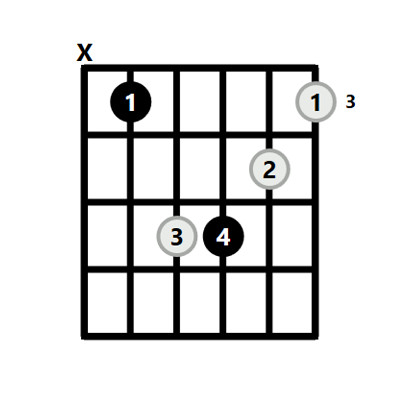 Cm Chord Guitar
Cm Chord Guitar
How to Play the Standard Cm Barre Chord (Step by Step):
- Barre: Place your index finger across all six strings at the 3rd fret. Ensure you’re pressing firmly enough for all strings to ring clearly.
- Third Finger: Place your ring finger on the 5th fret of the A string (4th string).
- Fourth Finger: Place your pinky finger on the 5th fret of the D string (3rd string).
- Second Finger: Place your middle finger on the 4th fret of the B string (2nd string).
- Strum: Strum from the A string (5th string) downwards. Avoid strumming the low E string for this particular voicing to clearly emphasize the root.
This barre chord shape provides a full and rich sound, making it suitable for various musical styles.
The “Easy” C Minor Chord Shape
For beginners or situations where quick chord changes are needed, an “easy” version of the Cm chord exists, utilizing only the top three strings.
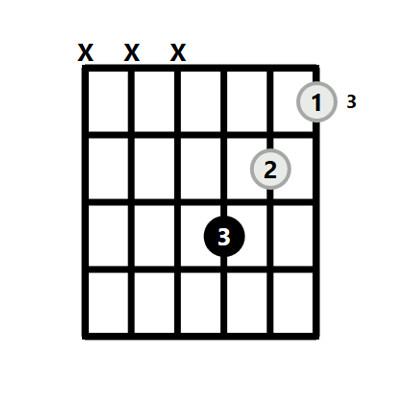 Easy Cm Chord Guitar
Easy Cm Chord Guitar
This simplified shape uses fewer fingers and less hand strength, making it a great starting point. However, it’s a partial chord and won’t have the same fullness as the barre chord.
Alternative “Easy” Cm Chord (Open Voicing – Less Common)
There’s another less common “easy” Cm chord that technically utilizes an open string.
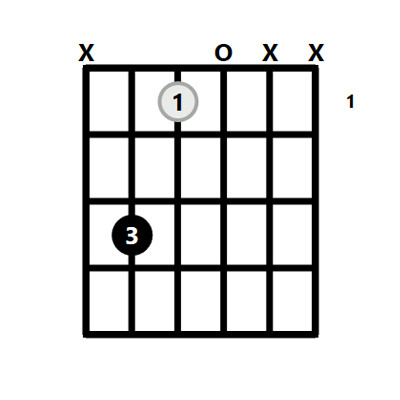 Easy Cm Chord Guitar 2
Easy Cm Chord Guitar 2
While valid, this voicing is often avoided due to its lower pitch and potentially “muddy” sound in certain musical contexts. It might be useful for specific sonic textures but isn’t a go-to Cm shape.
C Minor Root 6 Barre Chord Shape
Another essential barre chord shape for Cm is the “root 6” barre. This shape is based on the E minor barre chord shape and starts with the root note on the low E string. For C minor, you’ll play this shape starting at the 8th fret.
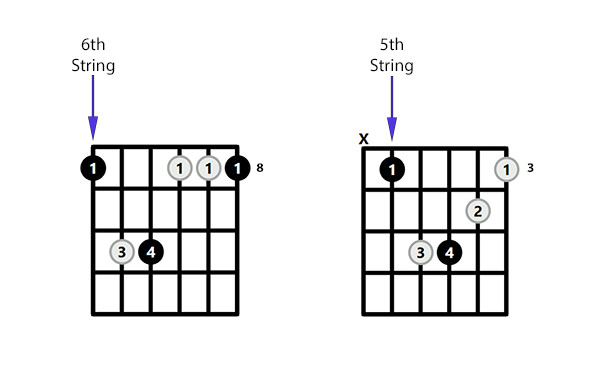 Cm Barre Chord
Cm Barre Chord
This shape provides a different voicing of the Cm chord, with the root on the lowest string, offering a fuller and sometimes bass-heavy sound.
Exploring C Minor Triads
Beyond full chord shapes, understanding and playing C minor triads is beneficial for expanding your fretboard knowledge and creating interesting voicings. Triads are three-note chords, containing the root, third, and fifth. For Cm, these notes are C, Eb, and G.
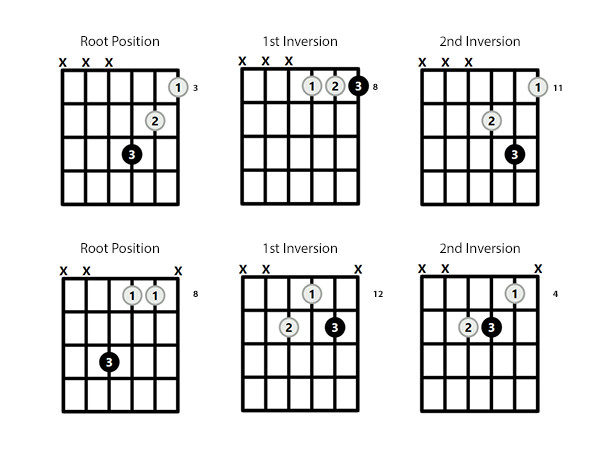 C Minor Triad
C Minor Triad
By rearranging these notes into different inversions (root position, 1st inversion, 2nd inversion), you can create various triad shapes across the fretboard.
- C Minor Triad (Root Position): C – Eb – G
- C Minor Triad (1st Inversion): Eb – G – C
- C Minor Triad (2nd Inversion): G – C – Eb
Learning these triad shapes enhances your understanding of chord construction and provides more melodic and less dense voicing options compared to full barre chords.
Where Does the C Minor Chord Fit In? Musical Context
Understanding where the Cm chord appears in music theory and common keys will help you use it effectively in your playing and songwriting.
- Keys Containing Cm Chord: The Cm chord is a diatonic chord (naturally occurring) in several keys:
- C minor: As the i chord, Cm is central to the key of C minor.
- F minor: Cm is the iv chord in F minor.
- G minor: Cm is the iii chord in G minor.
- Eb Major: Cm is the vi chord in Eb Major (its relative major key).
- Ab Major: Cm is the iii chord in Ab Major.
- Bb Major: Cm is the ii chord in Bb Major.
Knowing these key relationships allows you to predict where a Cm chord might appear in songs and helps you write your own progressions.
C Minor Chord Substitutions and Extensions
For adding color and complexity, you can explore substitutions and extensions for the Cm chord.
-
Common Substitutions:
- Cm7 (C minor seventh): Often used interchangeably with Cm, adding a jazzy or bluesy flavor.
- Cm9, Cm11, Cm6: These extended chords (minor ninth, eleventh, minor sixth) add further harmonic richness and emotion.
- Eb Family Chords: Since Eb Major is the relative major of C minor, chords like Eb6, Ebmaj7, Ebmaj9 can sometimes be used as substitutes, providing a brighter, related sound.
-
Scales for Soloing Over Cm: To improvise or write melodies over a Cm chord, consider these scales:
- C Minor Pentatonic: A fundamental blues and rock scale that works well over minor chords.
- C Natural Minor Scale (Aeolian Mode): The parent scale of the Cm chord, providing a natural minor sound.
- C Harmonic Minor Scale: Creates a more dramatic and exotic minor sound, often used in classical and metal music.
- C Melodic Minor Scale: Used for melodic passages, especially ascending lines, offering a smoother sound than harmonic minor.
- Blues Scale: Incorporates the “blue note,” adding a bluesy and expressive character.
Conclusion: Embrace the Power of the C Minor Chord
The C minor chord is more than just another shape to learn; it’s a gateway to expressing a wide range of emotions on the guitar. By mastering its various shapes, understanding its theoretical foundation, and exploring its musical context, you’ll significantly expand your guitar playing capabilities. Practice these shapes, experiment with substitutions, and listen to songs that utilize Cm to truly integrate this versatile chord into your musical vocabulary. Happy playing!

